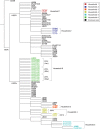Household Clustering of Escherichia coli Sequence Type 131 Clinical and Fecal Isolates According to Whole Genome Sequence Analysis
- PMID: 27703993
- PMCID: PMC5047392
- DOI: 10.1093/ofid/ofw129
Household Clustering of Escherichia coli Sequence Type 131 Clinical and Fecal Isolates According to Whole Genome Sequence Analysis
Abstract
Background. Within-household sharing of strains from the resistance-associated H30R1 and H30Rx subclones of Escherichia coli sequence type 131 (ST131) has been inferred based on conventional typing data, but it has been assessed minimally using whole genome sequence (WGS) analysis. Methods. Thirty-three clinical and fecal isolates of ST131-H30R1 and ST131-H30Rx, from 20 humans and pets in 6 households, underwent WGS analysis for comparison with 52 published ST131 genomes. Phylogenetic relationships were inferred using a bootstrapped maximum likelihood tree based on core genome sequence polymorphisms. Accessory traits were compared between phylogenetically similar isolates. Results. In the WGS-based phylogeny, isolates clustered strictly by household, in clades that were distributed widely across the phylogeny, interspersed between H30R1 and H30Rx comparison genomes. For only 1 household did the core genome phylogeny place epidemiologically unlinked isolates together with household isolates, but even there multiple differences in accessory genome content clearly differentiated these 2 groups. The core genome phylogeny supported within-household strain sharing, fecal-urethral urinary tract infection pathogenesis (with the entire household potentially providing the fecal reservoir), and instances of host-specific microevolution. In 1 instance, the household's index strain persisted for 6 years before causing a new infection in a different household member. Conclusions. Within-household sharing of E coli ST131 strains was confirmed extensively at the genome level, as was long-term colonization and repeated infections due to an ST131-H30Rx strain. Future efforts toward surveillance and decolonization may need to address not just the affected patient but also other human and animal household members.
Keywords: Escherichia coli infections; ST131; colonization; transmission; whole genome sequence.
Figures


References
-
- Russo TA, Johnson JR. Medical and economic impact of extraintestinal infections due to Escherichia coli: an overlooked epidemic. Microbes Infect 2003; 5:449–56. - PubMed
-
- Gerver S, Mihalkova M, Abernethy J et al. . Escherichia coli bacteraemia mandatory reports, 2014/15. Summary of the Mandatory Surveillance Annual Epidemiological Commentary, 2014/15. London: Public Health England, 2015: pp 4–5.
-
- Russo TA, Johnson JR. A proposal for an inclusive designation for extraintestinal pathogenic Escherichia coli: ExPEC. J Infect Dis 2000; 181:1753–4. - PubMed
Grants and funding
LinkOut - more resources
Full Text Sources
Other Literature Sources

